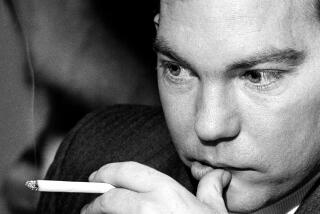BOOK REVIEW : The Bureaucrat Who Got Patton His Tanks : LUCIUS D. CLAY; An American Life <i> by Jean Edward Smith</i> ; Henry Holt: $29.95; 812 pages
- Share via
He was a new type of soldier, a master of warfare at mid-century. One of a remarkable band of similar men and women, he was a chair-borne bureaucrat, the great, often-scorned weapon that assured the Allied victory in World War II.
No battlefield honors for men such as Lucius D. Clay, West Point 1918, first in English and history, 128th out of 137 in military conduct.
Instead, autocratic, independent Lucius Clay found his way into the Corps of Engineers, and ultimately to Washington. There he dealt with a pork-barrel Congress, scattering vast river, harbor and dam projects about the country. He cooperated generously with the New Deal’s Civilian Conservation Corps and Works Progress Administration in civilian relief--and gained even more experience in managing huge enterprises.
(According to one of his sponsors, then-Sen. James Byrnes: Were Clay given six months, “he could run General Motors or U.S. Steel.”)
For 20 years, Clay and a small group of like-minded men gathered those political and managerial skills necessary to mobilize an army of 9 million when the nation finally roused itself to the menace of Hitler.
No Patton here. Only the deputy director of war mobilization who got Patton his tanks, Eaker his bombers, and Bradley, Clark and MacArthur their Jeeps and C-rations. This is dull stuff, but it was that very logistical capacity of the United States that won the war.
Still, logistics is not the sort of thing to transfix a biographer for the two decades that University of Toronto political scientist Jean Edward Smith has spent on this book. Rather, it is Clay’s tenure as military governor of Germany in the immediate postwar era, during four years of increasing Cold War tension, of Berlin blockade and airlift, that will assure the general as permanent a place in history as any man gets.
Not for nothing did the citizens of Berlin place at the foot of Clay’s grave at West Point a tablet that read: Wir danken dem Bewahrer unserer Freiheit (We thank the defender of our freedom).
A justly large part of Smith’s story then is given over to the remaking of Germany in a democratic image. And if Clay gets more credit as proconsul than he might deserve, well, Smith would not be the first biographer to enhance his subject’s image.
Some of that burnishing strains the record, however. Clay triumphs, in Smith’s account, because everyone else--the State Department, George C. Marshall, Dean Acheson, George Kennan, among others--is flawed, or weak, or conniving.
Similarly, Smith maintains that Clay “was not a militant cold warrior” but a keen student of geopolitics who believed that “the celebrated architects of Cold War containment were purchasing Allied unity at Germany’s expense.” (Indeed, Clay fixed a great deal of the blame for the failure of four-power government in Germany on the condemnatory French, not the war-weary Soviets.)
Be that as it may, it was this same general who on March 5, 1948, sent a calculated, back-channels cable to Washington warning that war “may come with dramatic suddenness.” The Clay cable triggered real alarm in the Truman Administration, and impelled a series of rearmament measures.
Yet Clay did not believe a word of his telegram; he made the assertion merely to goose a congressional committee into approving a budget bill the Army favored. It was not the last time a self-serving military officer exceeded his authority, then pleaded innocence.
Nor would this be the last time Clay influenced world affairs. Indeed, one might have wished Smith had devoted more attention to the later, political Clay. By then president of Continental Can Corp., Clay played a pivotal role in making his friend Dwight David Eisenhower the 34th President of the United States.
Clay, Tom Dewey and Herbert Brownell shaped Eisenhower’s pre-convention strategy and candidacy. Again, Smith may give too much credit to the politically adept Clay--at Ike’s expense--but he lays open Clay’s largely hidden role.
Clay the soldier, the diplomat, the politician, are all here in Smith’s sometimes cumbersome biography, a book flawed, like its subject, but a worthwhile addition to the record of our times.
Next: Jonathan Kirsch reviews “The Other California: The Great Central Valley in Life and Letters” by Gerald W. Haslam (Capra Press).

